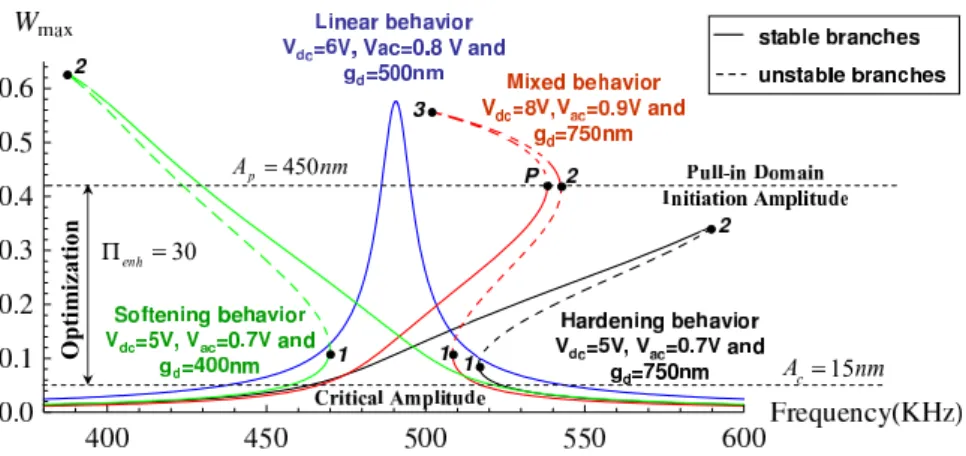HAL Id: hal-00505121
https://hal.archives-ouvertes.fr/hal-00505121
Submitted on 15 Nov 2019HAL is a multi-disciplinary open access archive for the deposit and dissemination of sci-entific research documents, whether they are pub-lished or not. The documents may come from teaching and research institutions in France or abroad, or from public or private research centers.
L’archive ouverte pluridisciplinaire HAL, est destinée au dépôt et à la diffusion de documents scientifiques de niveau recherche, publiés ou non, émanant des établissements d’enseignement et de recherche français ou étrangers, des laboratoires publics ou privés.
Mixed behavior identification in nonlinear
nanomechanical resonators
Najib Kacem, Sebastien Hentz, Sébastien Baguet, Régis Dufour
To cite this version:
Najib Kacem, Sebastien Hentz, Sébastien Baguet, Régis Dufour. Mixed behavior identification in non-linear nanomechanical resonators. IV European Congress on Computational Mechanics ECCM2010, May 2010, Paris, France. pp.CDRom. �hal-00505121�
ECCM 2010
IV European Conference on Computational Mechanics Palais des Congrès, Paris, France, May 16-21, 2010
Mixed behavior identification
in nonlinear nanomechanical resonators
N. Kacem12, S. Hentz2, S. Baguet1, R. Dufour11Université de Lyon, LaMCoS, CNRS UMR 5259, INSA-Lyon, Villeurbanne 69621, France, najib.kacem@insa-lyon.fr
sebastien.baguet@insa-lyon.fr regis.dufour@insa-lyon.fr
2CEA/LETI - MINATEC, 38054 Grenoble, France, sebastien.hentz@cea.fr
The small size of NEMS resonators combined with their physical attributes make NEMS quite at-tractive and suitable for a wide range of technological applications such as ultrasensitive force and mass sensing, narrow band filtering, and time keeping. However, at this size regime, nonlinearities occur sooner which reduce the NEMS dynamic range [1]. Consequently, a nonlinear multiphysics model is needed as a tool of performances optimization in resonant sensors for MEMS and NEMS designers.
To this end, the nonlinear behavior of resonators remains yet to be explored, and numerous models have been presented. Some models are purely analytical [2, 3] but they include coarse assumptions con-cerning nonlinearities. Other models [4, 5] are more complicated and use numerical simulations which make them less interesting for MEMS designers. In the present paper, a compact and analytical model including the main sources of nonlinearities (mechanical and electrostatic) is presented and validated thanks to the fabrication of a resonant accelerometer and the characterization of its sensing element, an electrostatically doubly clamped beam. A perturbation technique, the averaging method [6], has been used to obtain two first-order-nonlinear-ordinary-differential equations which describe the amplitude and phase modulation of the response and allows the computation of its stability. This analytical approach proves to be a powerful and quick tool for the sensor design, enabling the description of the competition between the hardening and the softening behavior (Figure 1), and thus the capture of all possible dy-namic behaviors, particularly, the mixed behavior characterized by four bifurcation points. Furthermore, the model may be used as a tool to enhance the dynamic range of the resonator, i.e. its detectability.
On the way from MEMS to NEMS, a "small" MEMS resonant accelerometer [1] shown in Figure 2a has been fabricated. The sensor structure has not been designed to display high inertial performances, but rather is a way to validate process [7], characterization and model choices. In order to electrically characterize its sensitive part (the resonator described in Figure 2b), the device was placed in a vacuum chamber (down to 1 mTorr), and the 2-port electrical measurements were performed at room temperature using a low noise lock-in amplifier (Signal Recovery 7280). The drive voltage is Vac= 0.5V and the beam
is polarized with Vdc= 10V . This ensures a mixed behavior as shown in Figure 3. The quality factor
obtained with this polarization voltage and in a linear regime is 4000. The critical amplitude [7] is then
Ac= 53nm, i.e. Vc= 25µV . The peak obtained is then far beyond Ac, up to 75% of the gap. The mixed
behavior is fully identified with its four bifurcation points using a sweep up frequency to capture the points P and 2 as well as a sweep down frequency for points 1 and 3. Moreover, we experimentally track the point P (mixed behavior initiation point) while varying the drive and the bias voltage and we show that this bifurcation point is fixed by the design parameters. Then, the mixed behavior can be retarded and avoided by designing resonators for which the P point amplitude is close to the gap.
Further measurements are under work to validate the dynamic range enhancement based on the com-pensation of the nonlinearities shown by the model.
Figure 1: Predicted forced frequency responses for several set of parameters. Wmax is the displacement
of the beam normalized by the gap gdat its middle point 2l.
Figure 2: (a): SEM image of the resonant accelerometer. (b): Schema of an electrostatically clamped-clamped resonator.
Figure 3: Analytical and experimental forced frequency responses showing a mixed behavior.
References
[1] Roessig T, Ph.D. dissertation, University of California, Berkeley, 1998. [2] Tilmans H A and Legtenberg R 1994 Sensors Actuators A 45 67–84
[3] Gui C, Legrenberg R, Tilmans H A, Fluitman J H J, Elwenspoek M 1998 J. Microelectromech. Syst. 7 122–127 [4] Najar F, Choura S, Abdel Rahman E M, El-Borgi S and Nayfeh A H 2006 J. Micromech. Microeng 16 2449–
2457
[5] Nayfeh A H, Younis M I, Abdel-Rahman E M 2007 J. Nonlinear Dynamics 48 153–163 [6] Nayfeh A H 1981 Introduction to Perturbation Techniques Wiley (New York)
[7] Kacem N, Hentz S, Pinto D, Reig B, and Nguyen V 2009 Nanotechnology 20 275501 (11pp).
